Cannabis and the United States military
Appearance
| Part of a series on |
| Cannabis |
|---|
 |

Cannabis usage is currently prohibited in the
United States military
, but historically it has been used recreationally by some troops, and some cannabis-based medicines were used in the military as late as the twentieth century.
Military medicine
In 1909, a military manual from the
American Expeditionary Force carry cannabis indica tablets to treat headaches, insomnia, and cramps.[2]
Drug use in Panama and investigations
Some of the earliest reports of recreational cannabis use in the military came from the
John Pershing's punitive expedition against Pancho Villa (1916–1917).[5] In 1921, the commanding officer of Fort Sam Houston in San Antonio, Texas, prohibited the use of cannabis on the base.[6]
A 1933 report by the
Marijuana Smoking in Panama, based on a study of U.S. Army personnel in the Panama Canal Zone, found that cannabis was generally not addictive and was less harmful to soldiers than alcohol.[7][8] The report recommended that use of cannabis on military bases should continue to be prohibited, but outside of these areas there should be no further restriction.[8]
Industrial hemp
The
hemp rope for the United States Navy.[10]
Edgewood Arsenal human experiments
From the 1950s to the 1970s,
Edgewood Arsenal conducted experiments on human subjects with cannabis and its derivatives.[11][12] One study indicated "no loss of motivation or performance after two years of heavy (military sponsored) smoking of marihuana."[13]
Vietnam War
Though alcohol was the drug most commonly used by American troops in the
101st Airborne.[15]
During the Vietnam War period, cannabis use also became common among US forces in the United States and in Europe, with a 1971 article claiming that over 1,000 midshipmen at
Annapolis Naval Academy used cannabis, and a survey in Germany showing that half of the soldiers in the surveyed battalion were regular cannabis users.[16]
References
- ^ United States. Mounted Service School, Fort Riley, Kan (1909). The army horse in accident and disease: edition: 1909. A manual prepared for the use of students of the Training school for farriers and horseshoers. Govt. print. off. pp. 110–.
{{cite book}}: CS1 maint: multiple names: authors list (link) - ISBN 978-1-4406-3387-4.
- ^ The International Journal of the Addictions. M. Dekker. 1982.
- ISBN 978-0-398-02690-5.
- ISBN 978-0-8166-4060-7.
- ISBN 978-1-891385-06-3.
- ^ Ruth C. Stern & J. Herbie DiFonzo, The End of the Red Queen's Race: Medical Marijuana in the New Century, Quinnipiac Law Review, Vol. 27, p. 688.
- ^ a b Marijuana Smoking in Panama, Military Surgeon, Vol. 73 (1933).
- ^ TAPPI Journal. Technical Association of the Pulp and Paper Industry. 1999. p. 114.
- ISBN 978-0-930031-93-0.
- ^ United States. Congress. Senate. Committee on the Judiciary. Subcommittee to Investigate Juvenile Delinquency (1975). Marijuana Decriminalization: Hearing Before the Subcommittee to Investigate Juvenile Delinquency of the Committee on the Judiciary, United States Senate, Ninety-fourth Congress, First Session ... May 14, 1975. U.S. Government Printing Office. pp. 942–.
- ^ Understanding the Social Costs of Marijuana Laws: With Emphasis on the Medical Aspects. The Committee. 1974.
- ISBN 978-1-4269-1540-6.
- ISBN 978-1-58562-825-4.
- ISBN 978-1-4289-1064-5.
- ISBN 978-0-8117-0831-9.
